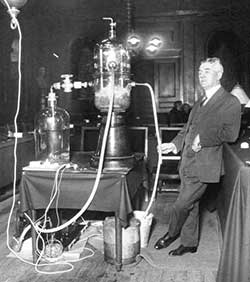December 1910: Neon lights debut at Paris Motor Show

Photo: Wikipedia Commons
Georges Claude
Paris is known as the “City of Light,” in part because it was the first to adopt gas street lighting. It also hosted the first neon lights, thanks to a French chemist and engineer who became known as the “Edison of Paris”: Georges Claude.
Experiments over almost two centuries pointed the way towards the gas discharge tube. Back in 1675, French astronomer Jean Picard noticed that his mercury barometer was emitting a faint glow. Eventually, physicists understood that electrons from mercury atoms were captured by the glass barometer tube, and then released when the level of the mercury dropped; these electrons excited mercury atoms in the vapor above the liquid. Much later, in 1855, a German physicist and glassblower named Heinrich Geissler invented the “geissler tube,” a long glass tube filled with gas that glowed when high voltage was applied across the tube.
The discovery of neon was part of the ongoing investigation of air. In 1775 Henry Cavendish observed a bit of gas residue after he tried to remove all the oxygen and nitrogen from a sample of air by fractional distillation. Then in the 1890s, the Scottish chemist William Ramsay identified neon, krypton, and xenon with M.W. Travers, and argon with Lord Rayleigh.
These gases also glowed with bright colors when high voltage was applied. Ramsay noted neon’s distinctive hue in his Nobel Prize lecture: it was “a brilliant flame-covered light, consisting of many red, orange, and yellow lines.” (Travers described it as a “blaze of crimson light.”) By the turn of the century, there were several varieties of electric discharge lighting available in Europe and the U.S.
Enter Georges Claude, who worked as an electrical inspector while dabbling in scientific invention. He figured out how to scale up the fractional distillation, and was soon capable of producing as much as 10,000 cubic meters of liquefied air each day. He co-founded his own company, L’Air Liquide, in 1902, selling his product to the steel industry in particular, and it quickly grew into an international corporation.
Claude had originally hoped to follow in Ramsay’s footsteps and make his own noble gaseous discoveries, but soon realized that “there was nothing more to be done.” Instead, he set about putting leftover neon produced as a byproduct from his liquefaction enterprise to good use. He disliked the overly bright electric lighting used at the time, and looked to all those previously invented gas discharge tubes for inspiration, as well as Edison’s hugely successful incandescent bulbs.
He particularly liked the design of so-called “Moore lamps,” invented by one of Edison’s former workers, Daniel McFarlan Moore. These were tall glass tubes with electrodes at either end, filled with nitrogen or CO2 at low pressure; they glowed white when high voltage was applied. But they were expensive and tended to leak, so Moore lamps never quite caught on. Claude replaced the CO2 with neon, and added a carbon filter so that impurities from the hot electrodes would not cause the electrodes to sputter and light to dim. Eventually he built 20-foot neon tubes capable of glowing for 1200 hours.
Claude quickly filed a patent, and displayed his neon tubes in December 1910, at the Paris Motor Show. People were dazzled, but the tubes weren’t ideal for general lighting.
But they were perfect for signage, and in 1912, Claude sold his first neon sign to a barbershop on the Boulevard Monmartre. Soon there was a large rooftop neon sign for Cinzano (an Italian vermouth) and entrance lighting for the Paris Opera. Claude founded his second company, Claude Neon, and made a fortune selling franchises for his neon lighting. He received a U.S. patent for neon lighting in 1915.
Automobile mogul Earle C. Anthony, the sole distributor in California for The Packard Motor Car Company, brought the first neon signs to America after seeing them during a visit to Paris. They were perfect for his showroom in downtown Los Angeles, and purportedly caused traffic jams because passersby kept stopping to admire the giant glowing orange-red tubes. It was dubbed “liquid fire.” Claude monopolized the market until the 1920s, when his original patents expired and his trade secrets leaked out to competitors.
Ultimately, Claude fell afoul of his own government. Never a fan of the French democratic system, he supported restoring the monarchy. During the German occupation of France in World War II, he became a Nazi collaborator. When the war ended, he was sentenced to life imprisonment, although eventually he was paroled after his fellow scientists pleaded for leniency on his behalf. He died in 1960 when he was 90.
Pure neon lighting glows orange-red. Investigators soon realized they could make other colors by using different gases — carbon dioxide for white, argon with a trace of mercury for blue, or helium for gold — and later expanded the palette even more by the judicious addition of phosphor coatings. In the 1950s and 1960s, neon tubes were key components in digital computer circuits, and in the first desktop calculators. The golden age of neon lighting is now over, but neon is still used for small simple signage, and fans of retro chic still seek out neon tubes out of nostalgia.
Further Reading
Boyd, Jane, and Rucker, Joseph. “A Blaze of Crimson Light: The Story of Neon,” Chemical Heritage Magazine, Summer 2012
Claude, Georges. “The Development of Neon Tubes,” The Engineering Magazine, November 1913, pp. 271-274
©1995 - 2024, AMERICAN PHYSICAL SOCIETY
APS encourages the redistribution of the materials included in this newspaper provided that attribution to the source is noted and the materials are not truncated or changed.
Editor: David Voss
Staff Science Writer: Emily Conover
Contributing Correspondent: Alaina G. Levine
Art Director and Special Publications Manager: Kerry G. Johnson
Publication Designer and Production: Nancy Bennett-Karasik
December 2015 (Volume 24, Number 11)
Articles in this Issue

